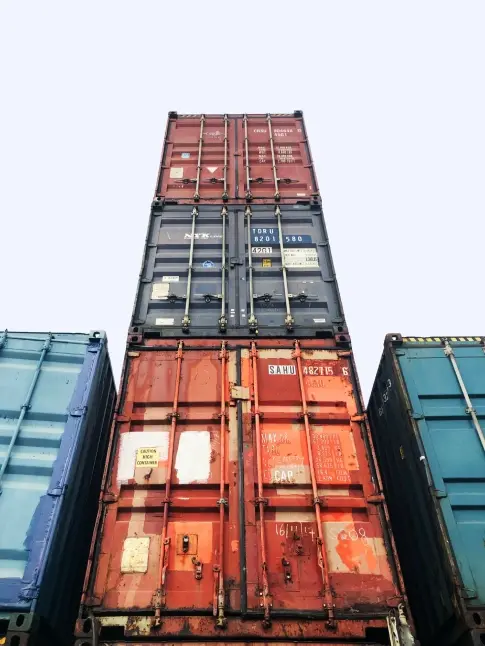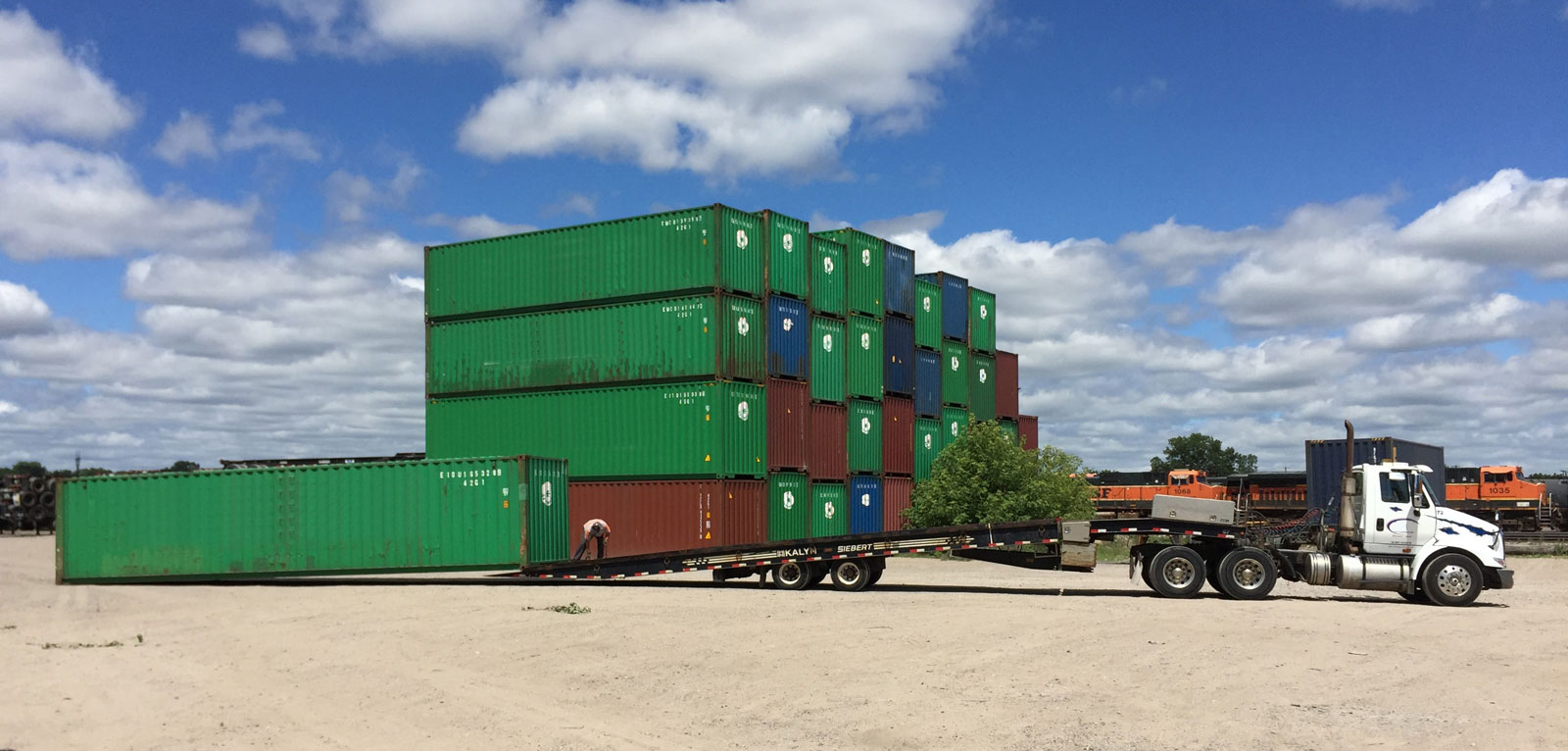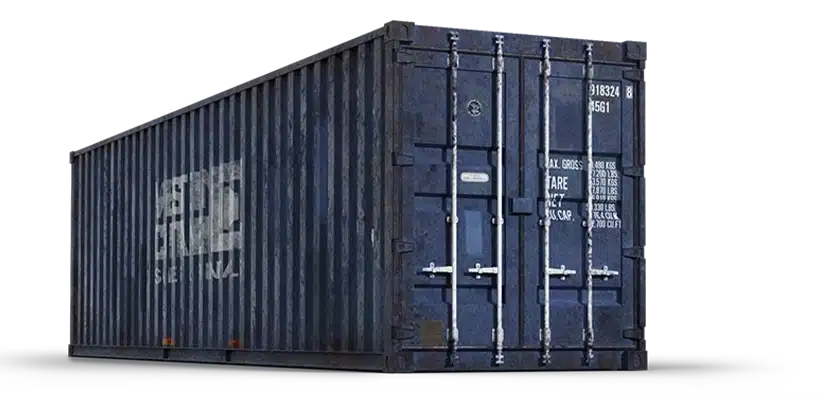Container Information
What are the shipping container dimensions?
You can find shipping container dimensions for all our available sizes on our Container Dimensions page.
WWT vs CWO Container (wind and watertight vs cargo worthy)
The only real difference between a Cargo Worthy (CWO) and Wind and Water Tight (WWT) container is whether it can pass a CSC Survey and be safely placed at the bottom of a stack of seven (7) loaded containers for shipment on a cargo ship. Both CWO and WWT are going to look similar: surface rust, dings and dents, etc.
Whether the used shipping container you purchase is WWT or CWO, it is going to look like a used metal shipping container. WWT boxes are more likely to have cosmetic issues simply due to their age, but all WWT containers can be repaired to CWO status.
With either option, we guarantee that your shipping container won’t leak, will have doors that seal, and floors free of holes. If you’re worried about how it looks, pressure washing and painting used containers goes a long way.
One Trip containers are Cargo-Worthy containers that were manufactured within the last 1-2 calendar years and generally have little to no cosmetic issues (maybe a few dings/dents and scraped paint from being stacked, but that’s it).
Do you sell refrigerated or insulated units?
We do not offer the sale of refrigerated containers due to the inconsistency and limited availability of the used inventory for sale. We refer customers that need reefer containers to ReeferContainerPros.com.
Do you sell 48′ or 53′ containers?
Due to limited inventory availability and the complexity of managing delivery of 48′ and 53′ containers, we do not offer them for sale or rent.
Why do 20′ cost more than 40′ sometimes?
Used container pricing is driven mainly by local supply, and 40′ shipping containers are a far more common size than 20′ shipping containers. Because containers are a byproduct of shipping, the containers that move the most cargo tend to be the most widely used. So 40′ shipping containers (standard and high cube) are the most common used container length and tend to be less expensive per square foot than 20′ shipping containers. Depending on supply, sometimes used 40′ shipping containers can even be the same price or lower in cost than 20′ shipping containers (however, usually 20′ shipping containers are a few hundred dollars cheaper than 40′ shipping containers).
Why are 10′ containers so expensive?
You can’t fit a lot of cargo in a 10′ shipping container, so they’re not a commonly used size for shipping companies. 10′ containers are usually only used for custom projects or as part of storage container rental fleets.
Do shipping containers have titles?
Using a container chassis has a title, but shipping containers do not have titles. In order to move a container, you’ll always need a chassis or trailer (which will require a title and vehicle registration), but the container itself does not require title or registration in the United States.
Container Issues & Condition
I’m having a tough time opening and closing my doors.
The biggest issue with tough doors is an uneven door frame. If the ground underneath the door frame is uneven, or the container is loaded heavy to one side, or on a surface that causes it to bend or twist, the doors won’t open and close properly. Container doors are built to be opened and closed when the container is sitting squarely on a chassis.
Over the course of 20′ or 40′, it’s possible for a container to twist just enough for the door frame to be out of whack. Placing wood blocks under the door frame at the corner posts is the best way to solve that problem before it starts. You can also use an industrial lubricant on the hinges and work the doors back and forth for a few minutes to loosen them up.
What if the container isn’t what I expected when it’s delivered?
The customer has the right to refuse delivery if for some reason the container does not meet the criteria requested at purchase. Our goal is to give you a realistic idea of what you’re getting up front. Check out our sample photos and read about the process before purchasing a container for the first time. If the container is rejected because the truck cannot safely drop the container exactly where you wanted it, the customer will be charged for trucking as well as a re-stock fee of 15% (when applicable).
Neither you nor Western Container Sales wants the container to be rejected at delivery. Please make sure you see our container gallery and have a full understanding of what you’re getting before you purchase for the first time. If you’ve looked at everything on the site, and you’re still not sure, give us a call. We’re always happy to help.
Can I look at the shipping container before I buy it?
Because the containers are stacked at the intermodal depot, we cannot obtain photos or guarantee a specific unit. The depots are storing empty shipping containers for shipping lines and intermodal equipment providers. When we place an order for our customers, they pick the next container off the stack that meets their criteria.
The shipping containers we sell come directly from the intermodal depot, and because depots are so busy they don’t have the ability to let customers select from a wide variety of container options. Additionally, not every container in the stack is for sale (over 95% of containers at depots are not available for sale and are still being used for cargo). Unfortunately, this means that we’re unable to allow customers to pick a specific container. We do guarantee every container we sell, and do our best to set realistic expectations as to what your container might look like.
I bought a One Trip container and it has a strong paint smell. How do I make it go away?
One Trip containers sometimes have a paint or chemical smell because they’ve had their doors closed for 99% of the time since being built. If you buy a One Trip container and it has a paint smell, we recommend leaving the doors open for a few days to let it air out. If you’re still having issues after that, give us a call, but letting the container air out usually does the trick.
I have a used container with an odor, how can I get rid of it?
Similar to one trip containers, used containers have their doors closed with minimal air circulation for 99% of their existence. It’s not uncommon for a container to have a lingering odor, and it can usually be resolved by opening the doors and letting it air out (industrial strength odor neutralizers also help, and can be purchased at most hardware stores). If you’ve ever been in a semi-trailer, your container will probably smell similar to the inside of a semi-trailer.
What’s an “A Grade” container?
A lot of our competitors use grades like “A Grade” but that’s a bit misleading, we think. If you call the big national rental companies and they tell you they can sell you an “A Grade” box that just means a container that is wind/water tight and may or may not have been painted since they bought it. Or maybe it’s got less rust than you’d normally expect on an average WWT grade unit. Either way, it’s a grading system totally based on opinion and we’ve seen a lot of variability as to what people call “A Grade” around the country. If you hear “A Grade” you can safely translate it to “WWT” condition.
Moving Containers
I need to export my container, can you help with that?
Exporting a container is far more complex than buying one. We highly recommend all customers who need to use their container for export work with a freight forwarder first, and then reach out to us to buy the container about a week or two before you plan to pick it up. We also recommend that your freight forwarder coordinate all of the trucking. Because we offer ground level delivery, and can’t move loaded containers, you’ll likely need a crane to load your container onto the chassis when the truck comes to pick it up. A simpler option is to work with your freight forwarder to arrange a hauler to drop the container on a chassis so you won’t need a crane to load it onto the trailer later.
If you’re buying a shipping container to be used for export, you can add a CSC Survey to your purchase (please note, surveys add 3-5 business days to the normal timeline). We are happy to provide a Cargo Worthy (CWO) container, as well as coordinate a CSC survey at the depot prior to your hauler picking up the container. Learn more about CSC surveys.
Do you move loaded containers?
We do not move loaded containers under any circumstance. If you need moving services, we suggest calling companies like PODS.
I already have a container, can you move it?
We do not move containers we did not sell/rent. If you need an existing container moved, we recommend working with a local heavy haul company or heavy duty wrecking/towing company.
Delivery & Pickup
How much room is needed to deliver a shipping container?
Our delivery truck needs 120 linear feet to deliver 40 & 45ft containers and 75 linear feet to deliver 10 & 20ft containers. Both truck types need clearance from obstacles of 12 feet wide & 13.5 feet high (up to 16ft high when tipped at delivery). See Delivery Info for more.
How should I prepare the site for container delivery?
Check out Delivery Info for an overview and the delivery process. The most important thing is to have enough room for the truck to drop the container. 20 & 10ft containers require 75 linear feet of space, while 40 & 45ft containers require 120 linear feet of space. If a 20′ container is delivered on a semi (for instance if multiple 20’s are being delivered on the same truck) please account for the additional space. If delivery is rejected due to the driver being unable to safely back into the location, the customer will be charged for trucking plus a re-stock fee of 15%, so please make sure you have adequate space at your location.
The location also needs to be level. You can either lay concrete or gravel, or you can place railroad ties or blocks capable of supporting the container. A good rule of thumb on railroad ties or blocks is to have on under each end and then additional blocks every 10′ or so (depending on your surface area). A level surface is crucial to doors lining up, so blocks are a good idea to have in place. Western Container Sales does not provide blocks, so please make sure you have your site ready at delivery.
Can I pick up the shipping container myself?
We’re happy to load your truck at the depot if you have the proper equipment to safely transport a shipping container (if you don’t have a truck capable of safely hauling a container, we can help you with delivery). After purchase, we will provide you with a release number and pick-up information. You can then go to the intermodal depot on the release and have the container loaded on your truck. Please be aware you are required to comply with all DOT and OSHA rules while at the intermodal depot and Western Container Sales cannot be liable for any issues during transport.
Payment
How secure is the online payment?
We take your online security seriously. All payment processing happens on secure third party sites like Stripe, Bread, or Shopify’s Payment Gateway (credit cards used in the Shopify portal are processed by Shopify Payments, which is powered by Stripe, and credit card payments for rentals are processed by Stripe). Western Container Sales uses these third party sites because they are industry leaders in eCommerce transactions. Stripe is trusted by companies like Pinterest and lyft for processing online payments.
Beyond the payment, our website is validated with the high level SSL encryption. Because all of our payment processing is managed by third parties, Western Container Sales doesn’t keep complete information regarding your credit card or payment method (only enough to identify your transaction). Our goal is to ensure a high level of transaction security for all of our customers.
Do you offer shipping container financing?
We have partners that offer shipping container purchase financing for businesses and individuals. We also offer payment terms to qualified businesses wishing to place their order using a PO. For individuals, we’ve partnered with Bread to offer shipping container financing at rates as low as 0%. Select Bread as your payment option at checkout and you’ll be redirected to their website to complete your purchase.
For businesses we’ve partnered with CIT to offer container financing options to companies that would prefer to pay for their shipping container purchase over time. You can complete CIT’s business credit application here. We also offer payment terms to qualified businesses. To pay with a purchase order, please complete our payment terms credit application.
Do you offer volume discounts for multiple shipping container purchases?
We offer a 5% volume discount for multi-unit orders that’s calculated at checkout. We can offer deeper discounts for customers who plan to purchase more than 10 shipping containers at a time. If you’d like pricing for a large volume order, please contact us.
Is there sales tax on the purchase of a shipping container?
That depends on where you take delivery. Western Container Sales primarily acts as a broker, helping customers buy shipping containers from international logistics providers with equipment in local intermodal depots. At this time we charge sales tax in about half of the markets we service, however that can change at any time.
We do not charge sales tax if the buyer is tax-exempt (form must be provided to Western Container Sales prior to purchase; please contact us if you believe your purchase should be tax exempt). Please note that Agriculture Exemptions are not applicable, and a valid sales tax exemption certificate must be provided. We make every effort to comply with local and national tax laws, so please note that this may change at any point.





